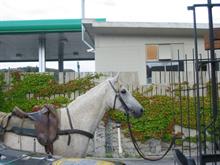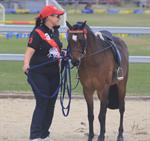Learn about Horse Behaviour - Horse Training without tears
Understand and recognise what constitutes normal behaviour in your horse and learn to respond appropriately to abnormal behaviour.

ACS Student Comment: "[The course] was more in depth than I thought it would be and it was information that I could apply with my own horses. The feedback was very helpful and it was information that could only have been gained from experience with horses. She [tutor] would always answer any questions that I have and always had something positive and helpful to say!" Paula Grima, Australia - Equine Behaviour course.
The study of equine behaviour provides a foundation for more sensitive and informed care and training of horses. Lessons cover genetics, perception and behaviour, communication and social behaviour, sexual and reproductive behaviour, learning and training and behavioural problems.
"This is a fascinating topic. Anyone who works with horses will get value from completing the course. Horses are large animals in relation to their human trainers and they cannot be trained safely or effectively using brute force. Having a deeper understanding of equine behaviour and intelligence will allow you to minimise the frustration you may often feel when trying to handle your horse." J. Pollock - B. Sc. (Biology), Dip. Prof. Ed. Tutor
Lesson Structure
There are 7 lessons in this course:
Lesson 1 - Introduction: Influences and Motivation
- What is an equine?
- Why study equine behaviour?
- Scope of equine behaviour
- What motivates behaviour?
- Categories of behaviour - reactive, active, cognitive
- Species behavioural differences
- Learned behaviour and learning ability
- Other influences on behaviour
- Behavioural differences between breeds
- Related terminology
Lesson 2 - Genetics and Behaviour
- Inborn, innate or inherited?
- Understanding the basics of genetics
- Effects of the environment
- Heritability, epigenesis, interaction between species, survival
- The importance of inborn behaviours
Lesson 3 - Perception and Behaviour
- How do animals perceive things?
- Imprinting
- Types of stimuli
- Stimulus filtering
- Equine perception and behaviour
- Sensory perception - horse verses human
- Sight, taste, smell, touch, sound
- The body language of horses
- Fight or flight
- Terminology
Lesson 4 - Communication and Social Behaviour
- Animal societies
- Social constraints and herd membership
- Signals of communication - chemical, tactile, visual signals
- Social organisation - home range
-
Maintenance behaviour
- Play behaviour
- Lack of equine company
Lesson 5 - Sexual and Reproductive Behaviour
-
Sexual strategies
- Normal sexual behaviour - stallions, mares, mating, birthing
- Foal imprinting
- Normal maternal behaviour
- Abnormal sexual behaviour - stallions, mares
Lesson 6 - Learning and Training
- Conditioning and learning
- Shaping, extinction, habituation, instrumental learning
- Thorndyke's Law of Effect
- Operant and respondent behaviour
- More aspects of conditioning - pseudo-conditioning, interoceptive conditioning, temporal conditioning
-
Biological aspects of conditioning
- Cognition and learning
- Associative learning
- Obedience, reinforcement, punishment
- Reinforcement schedules
- Flooding, Systematic desensitisation, exhaustion, punishment, habituation, counter conditioning, join-up/follow-up
Lesson 7 - Behavioural Problems
- Abnormal behaviour
- Types of abnormal behaviour in horses
- Diagnosing behavioural problems
- Domestication
- Stress
- Stereotypes
-
Stable vices - crib biting, wind sucking, weaving etc
- Prevention
- Ridden vices - shying, tongue over bit, head tossing, rearing, bucking etc
- Handling vices - leading, unwillingness to be caught, etc
- Transporting horses - problems during loading, horse trailer requirements
Each lesson culminates in an assignment which is submitted to the school, marked by the school's tutors and returned to you with any relevant suggestions, comments, and if necessary, extra reading.
Aims
- Identify factors affecting equine behaviour
- Describe the influence of genes on equine behaviour.
- Explain how horses perceive and how they respond to various stimuli
- Explain how horses communicate and the nature of their social organisation.
- Explain the sexual and reproductive behaviour of the horse.
- Describe the different ways that horses learn and how this can be applied to the training environment
- Explain how and why behavioural problems occur and how they can be prevented
 Course Duration: An average of 100 hours, self paced study
Course Duration: An average of 100 hours, self paced study
Why Study Horse Psychology?
1. To be able to understand and recognise “normal” behaviour and from this be able to identify and do something about “abnormal” behaviour. This is particularly important for domesticated animals and allows horse owners to be able to recognise signs of distress / stress, allowing the management and care of the horse(s) to be improved.
2. Knowledge of equine behaviour can also assist in training. By knowing how a horse is likely to behave in a certain situation allows the rider to prepare for the eventuality, and to either avoid or resolve that particular situation in an informed manner.
Start by Understanding the Range of Horse Behaviours
It is important for horse handlers to be aware of and to understand the range of behaviours that horses commonly display. This will ensure that the handler is always ready and prepared to deal with a horse’s reaction in different circumstances and environments.
Dominance hierarchies
Horses are sociable animals and prefer to live in herds or groups in both wild and domestic situations. Every herd has a well-defined pecking order known as a dominance hierarchy. The ‘alpha’ member of the herd is often an old experienced mare who the rest of the herd is submissive to; she makes the decisions for the herd and they trust her and will follow her lead. When working with horses the human handler takes on the role of the alpha herd member and the horse will look to its handler for direction and leadership. Consistent commands and a calm but assertive approach is required for the handler to effectively establish himself as the horse’s leader.
Epimeletic Behaviour
These behaviours are related to giving care and attention, commonly between a mare and foal but also between other unrelated horses. Horses standing together in the shade, ‘swishing’ flies from one another is an example of an epimeletic behaviour.
Investigative Behaviour
These are behaviours and activities associated with curiosity or the exploration of new surroundings or objects. Curiosity is part of the horse’s natural behavior and handlers must take appropriate steps to reduce potential injury and accidents caused by this curiosity. When a curious horse does get into a potentially dangerous situation, calm and tactful handling will reduce the horse’s tendency to panic and run away.
Grooming Behaviour
Mutual grooming behaviours are often observed in horses. These behaviours help to increase the social bonds between herd members. Studies have also shown that mutual grooming causes an increase in ‘feel good’ hormones. Horses often develop their own favourite grooming partners that they regularly carry out this behavior with.
Ingestion and Elimination Behaviours
These are behaviours and activities associated with eating, drinking, defecating and urinating. The horse’s digestive system has developed in such a way that the horse is a trickle feeder that prefers to spend the majority of its day moving around foraging and grazing. Restriction of this natural feeding behavior can cause stress in some horses and may contribute to the development of unwanted stereotypical behaviours or vices.
Some horses choose to urinate and defecate in a specific area of their enclosure while others are not as choosy. Stallions may choose to urinate and defecate on top of other horses fecal piles as a way of demonstrating his presence to the rest of the herd and his ‘ownership’ of the mares within the herd.
Play
Horses are naturally gregarious animals and often exhibit play behavior when turned out in a group. These behaviours can help to release pent up energy, re-affirm their positions in the herd ‘pecking order’ and act as a form of stress relief.
Mimicry
This is a contagious or infectious behavior when one horse copies the behavior or actions of another. For example, if one horse starts running, others are likely to follow suit. This behavior can be usefully utilised in training, for example using another horse as a ‘lead’ over a jump or past a scary object.
 Learning
Learning
The horse has a very long memory, which is very useful in training. The horse will remember that it was rewarded for displaying certain behaviour and will usually choose to behave this way again. He will not often repeat behaviour for which he was punished. Handlers must be consistent in rewarding and punishing horses so that the horse clearly knows what behaviour is expected. Horses learn by a system of repetition – reward and correction. They have no reasoning power so reward or correction must be immediate.
The horse has a short attention span; however horses remember frightening things for a long time. If the horse is reminded of a frightening experience he will show signs of fear. An unsympathetic handler will punish the horse for behaving badly. This is unjust. A good handler will reassure the horse so that he loses his fear and behaves well again.
Sleeping/waking
Like humans, horses develop their own individual sleeping/waking patterns. Their anatomy enables them to sleep while standing up, which allows them to be ready to flee if a perceived threat appears. Horses will generally only lie down to sleep when they are very settled and feel safe in their environment. Some horses will sleep at night and some during the day.